New York Style Bagels
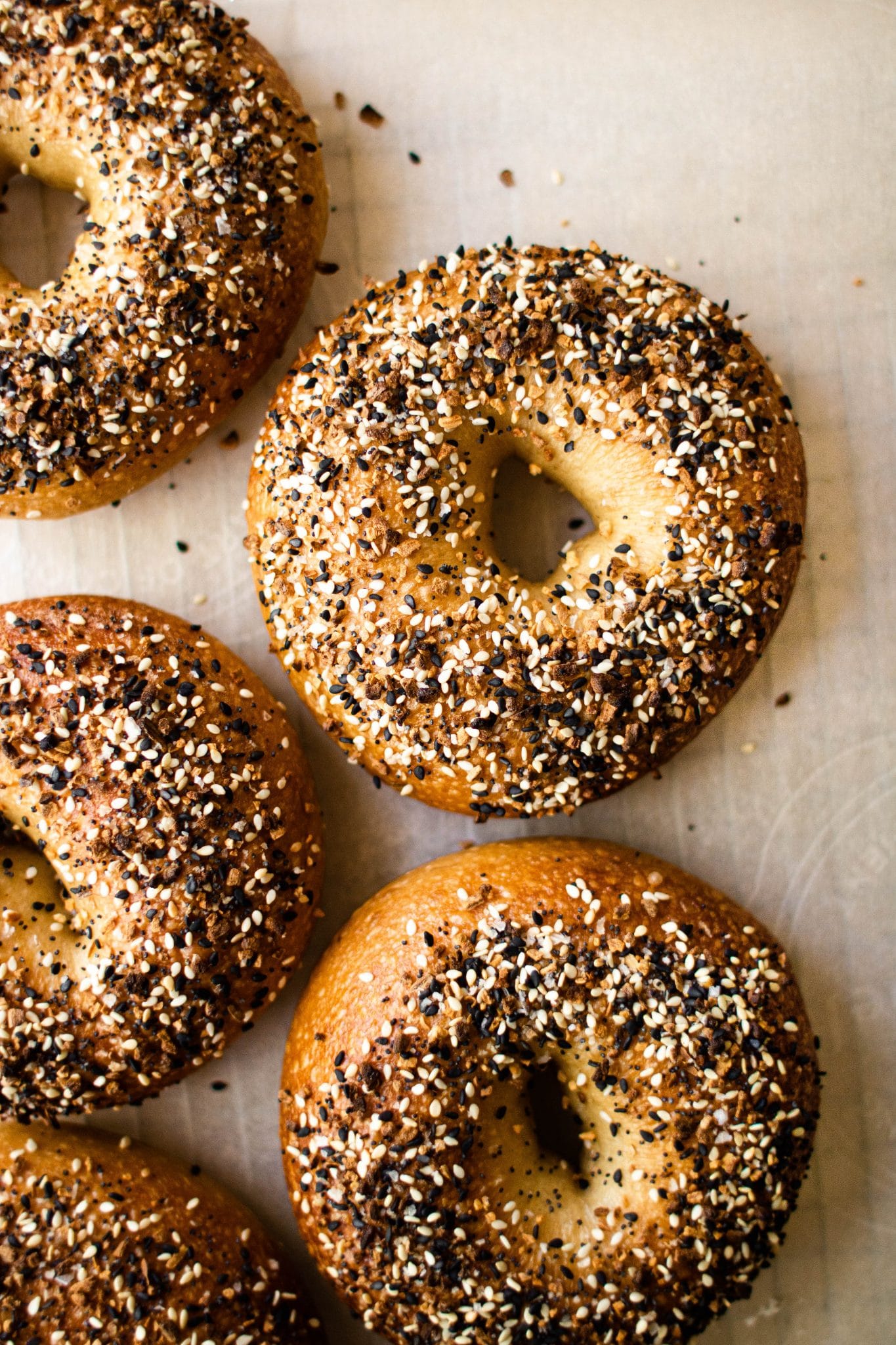
I have been making these New York style bagels pretty regularly, but the photos from two years ago really aren’t doing these bad boys justice. Now, what exactly is a New York style bagel? A New York style bagel is actually the original bagel to be served in the US and originated in the lower east side.
There are several characteristics that set a New York style bagel aside from other bagels but the main one is boiling the bagels. A New York style bagel is always boiled in water with barley malt and it gives the bagels their characteristic shiny crust and chew.
I grew up eating bagels. Usually from a bag from the grocery store, sometimes from a little nothing-special corner shop. I always liked bagels, but never felt like I understood the religious-style hype. It wasn’t until I went to NYC for the first time that I truly understood their majesty.
For everyone who believes that bagged grocery store bagels are akin to handmade New York style bagels– you are just wrong. Sorry, there’s no ifs, ands, or buts about it. Until you’ve had the hand-crafted gluten goodness that is a warm bagel, you simply have not lived. And while you may think that great bagels are unachievable in the home kitchen, I am here to prove you wrong.
Tips for making NY Style Bagels
FLOUR. You should be using a flour with a high protein content. All purpose flour simply won’t cut it and won’t develop the appropriate amount of gluten for a nice, tight crumb. Find out which flour that’s available to you has the highest protein content. I find that King Arthur flour has a good percentage and is generally readily available.
MIXING. Bagel dough requires a ton of mixing and so I do not recommend doing this by hand unless you have kneading endurance like a beast. This will even be difficult work for your stand mixer, in the ballpark of at least 20 minutes. If you want to use a food processor, which will work the dough more quickly, that’s possible. But you will have to do the initial rise with yeast, sugar, water and half of the flour. That mixture would then be added to the food processor with the remaining flour, diastatic malt powder, and salt and mixed until a smooth dough is achieved.
SHAPING. Now, there are plenty of experienced bakers who prefer the loop method. This is where each portion of dough is rolled into a rope and looped around your hand and rolled along the seam to seal the two sides of the dough together. I’ve attempted this method, and it works okay, but usually i end up with very ugly bagels–not smooth and glossy bagels.
Therefore, I have found that the “hole poke” method is the easiest for the average person making bagels. Each portion of dough is rolled into a tight ball, allowed to rest (covered), and then you poke a hole through the center and use your fingers to enlarge it. The important part here is to make the hole large enough. It’s going to look too large when you do it, but keep in mind that the bagels will swell when they boil and then when they bake. Check out my little time lapse video below!
BOILING. Boiling bagels is part of the secret to delicious NY bagels. A lot of folks use a mixture of water and barley malt syrup but I take it one step further and add a bit of baking soda to my water mixture for a beautiful golden brown crust. It is extremely important that your water be lightly boiling so that it’s hot enough to penetrate the dough. Adding your bagels to simply steaming water will result in small, dense, and tough bagels.
BAKING AND TOPPING. After the bagels come out of the water, they will be at their maximum stickiness so that’s the time to add your toppings. I opted for everything seasoning (everything bagels are scientifically proven to be the best bagels). I have all the ingredients for everything bagel spice, but honestly I just use the Trader Joe’s Everything But the Bagel spice because it’s perfect and delicious. So, make your life easy and buy a little bottle for $2, rather than hunt down 5 different spices. Bake the bagels at 425 degrees F for about 20 minutes, rotating halfway through, until they are golden brown.
More Recipes to Try
fluffy dinner rolls two ways
the very best cinnamon rolls
Same Day Pizza Dough
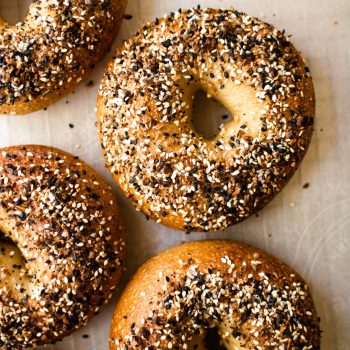
NY-Style Bagels
Ingredients
Sponge:
- 375 g (about 1 2/3 cups warm water), about 90 degrees
- 20 g (1 1/2 tablespoons) sugar
- 3/4 teaspoon active dry yeast
- 325 g (about 2 1/3) cups bread flour
Bagels:
- 325 g (about 2 1/3 cups) bread flour
- 30 g (about 3 tablespoons) diastatic malt powder
- 10 g (about 2 teaspoons) kosher salt
- all the sponge from above
Boiling water:
- 2-3 quarts of water, your pot should be 1/2 full
- 1/4 cup barley malt syrup
- 1/2 teaspoon baking soda
Instructions
- To make the sponge: In the bowl of a stand mixer, mix all the ingredients together with a wooden spoon until well combined. Cover with plastic wrap, transfer to a warm area and allow the sponge to rise until tripled in size with lots of bubbles, about 3 hours.
- After the sponge has fermented, add the remaining flour and the diastatic malt powder. Using the dough hook attachment, mix on medium-low speed until the dough starts to come together. Sprinkle in the salt and continue to mix. You'll need to mix the dough for about 20 minutes, so set a timer. The dough should be smooth and elastic at this point. Cover the bowl with a damp kitchen towel and allow the dough to rest for 15 minutes.
- Line a baking sheet with parchment paper and lightly spray with nonstick coating. Using a scale, portion the dough into 130g pieces and place them on the baking sheet and cover with a damp towel so that the dough doesn't dry out. Working with one piece of dough at a time, shape the dough into a tight ball. Cup the dough under your rounded hand, and working in tight circles on a work surface, roll until the dough is smooth and the seam on the bottom is sealed. Return to the baking sheet and cover with a damp cloth. Let the pieces rest for 10 minutes.
- Using a damp finger, poke a hole through the center of the dough ball and enlarge the circle so that the bagel is about 4 inches in diameter with a hole that is about 1 1/2 inches. The hole might look large, but the bagels will swell when they rise. Transfer the bagels to the greased baking sheet and cover with plastic wrap and refrigerate overnight.
- Preheat an oven to 425 degrees F. Fill a large pot or dutch oven with at least 3 inches of water. Add the barley malt syrup and bring to a boil. Add the baking soda and stir well to combine. This is important, if the water isn't boiling, you'll end up with small, tough bagels. Working in batches of 3-4, boil the bagels for 1 minute on each side. Transfer to a baking sheet lined with parchment paper (let the water drip off of them before transferring them) and sprinkle with your choice of topping. I recommend only baking about 4 off at a time so that the bagels don't sit too long after boiling.
- Bake for 20-25 minutes, until golden brown, rotating the tray halfway through. Transfer the bagels to a rack for cooling. Repeat with the remaining bagels. Bagels will keep for 4-5 days in a sealed storage bag at room temperature.


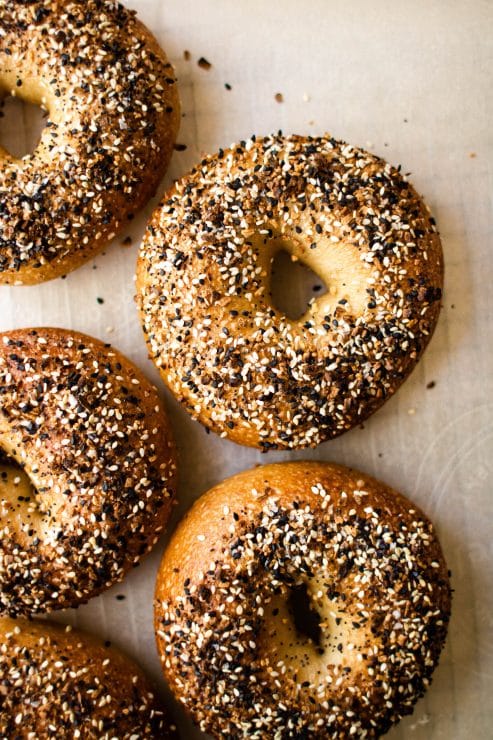
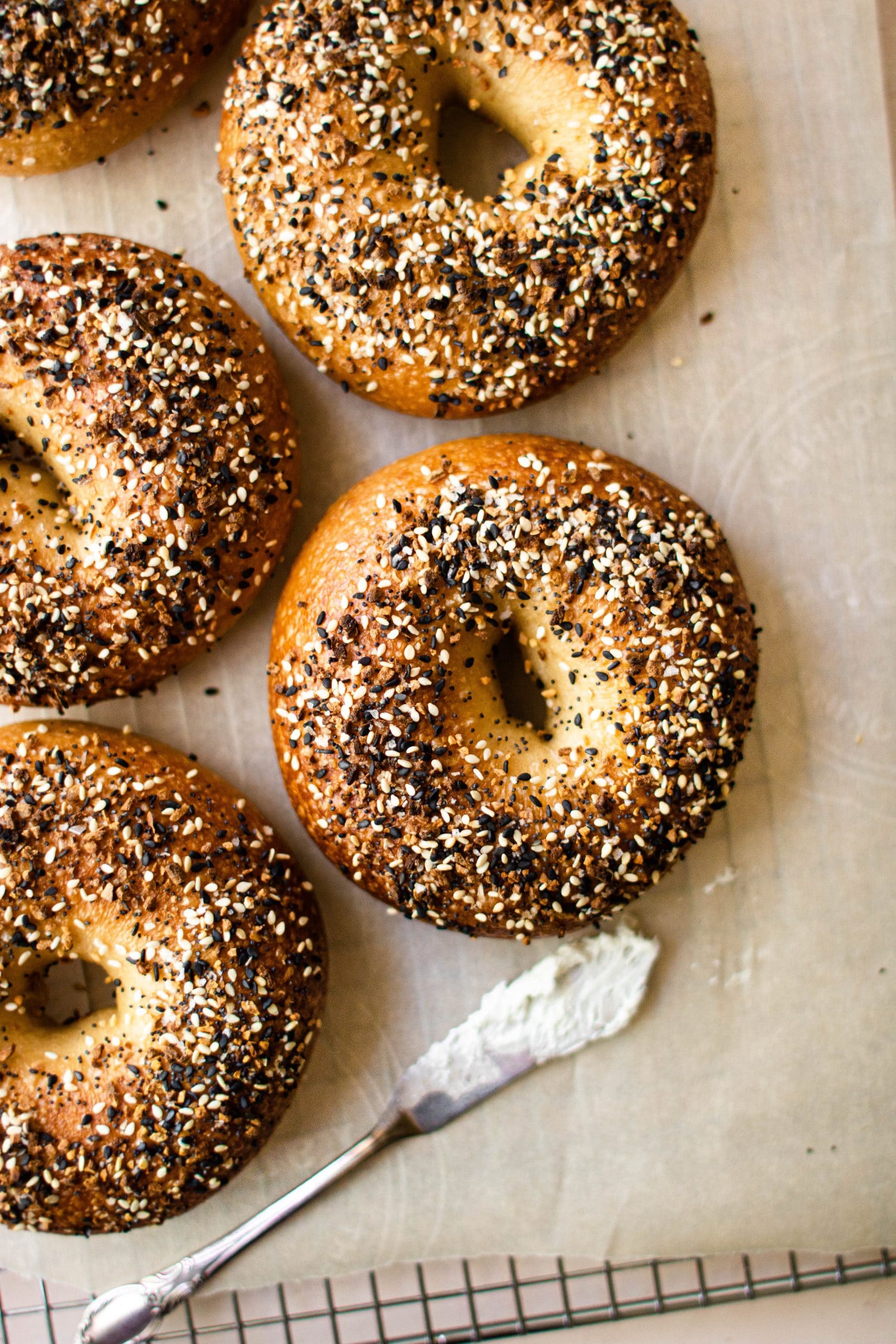
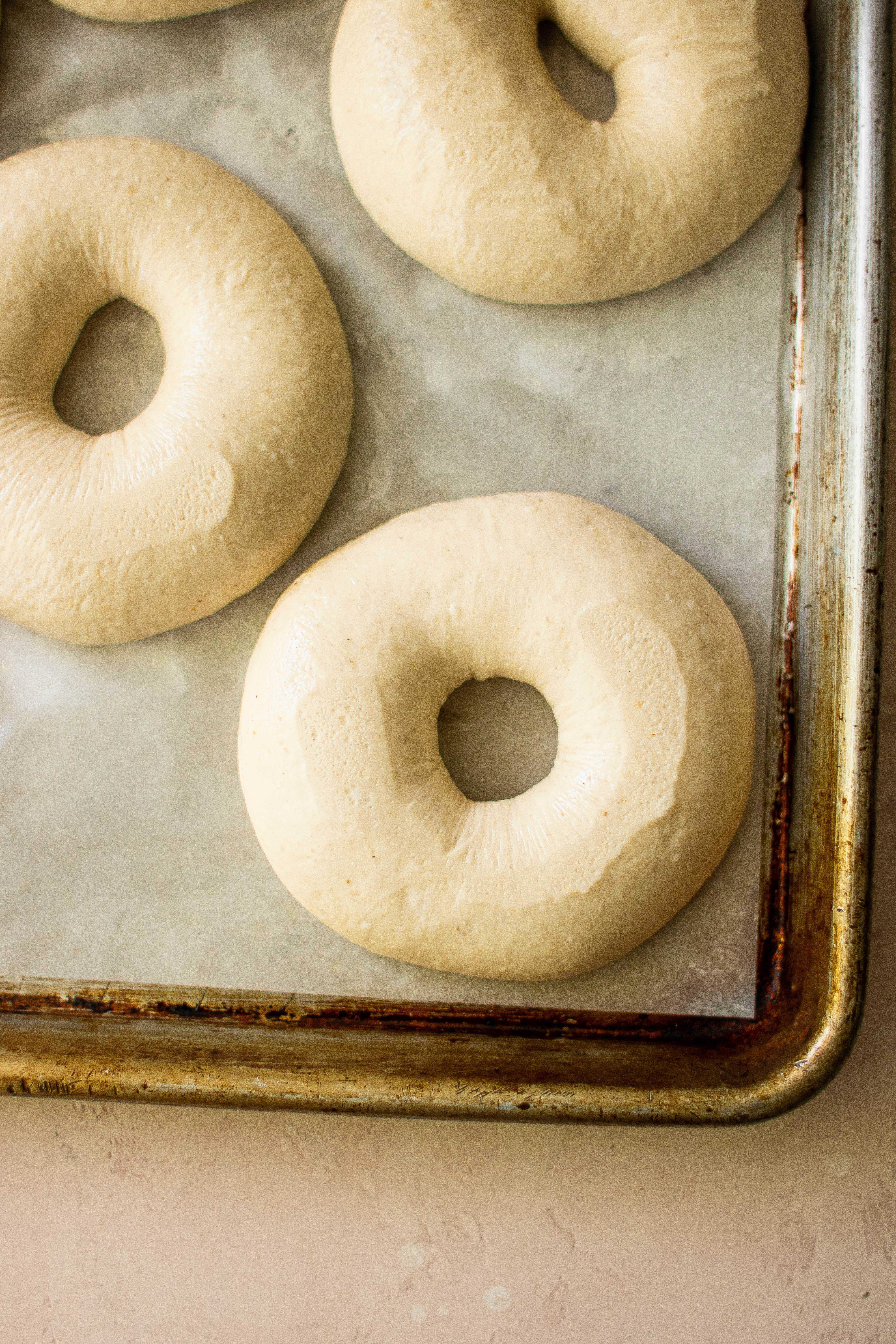
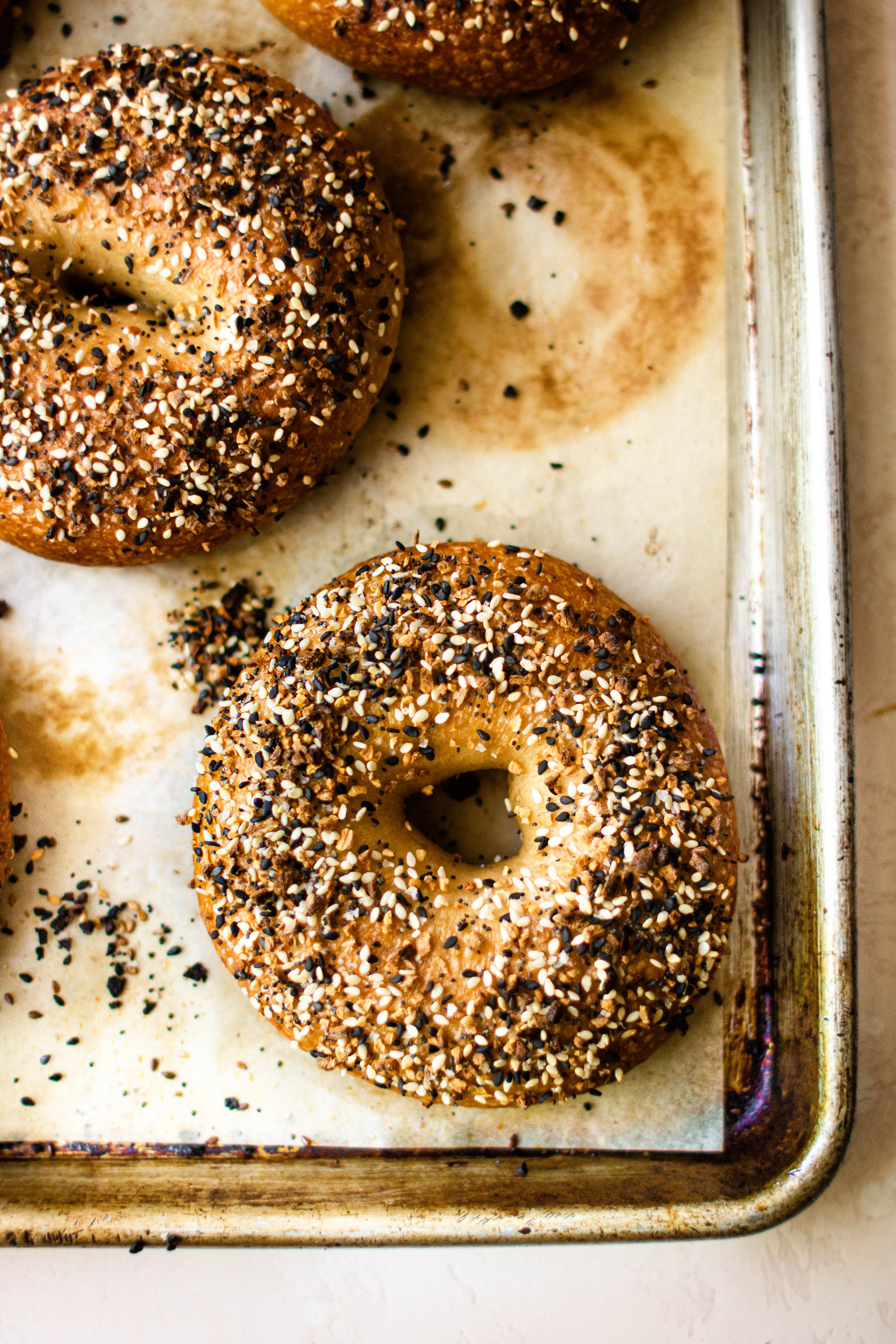
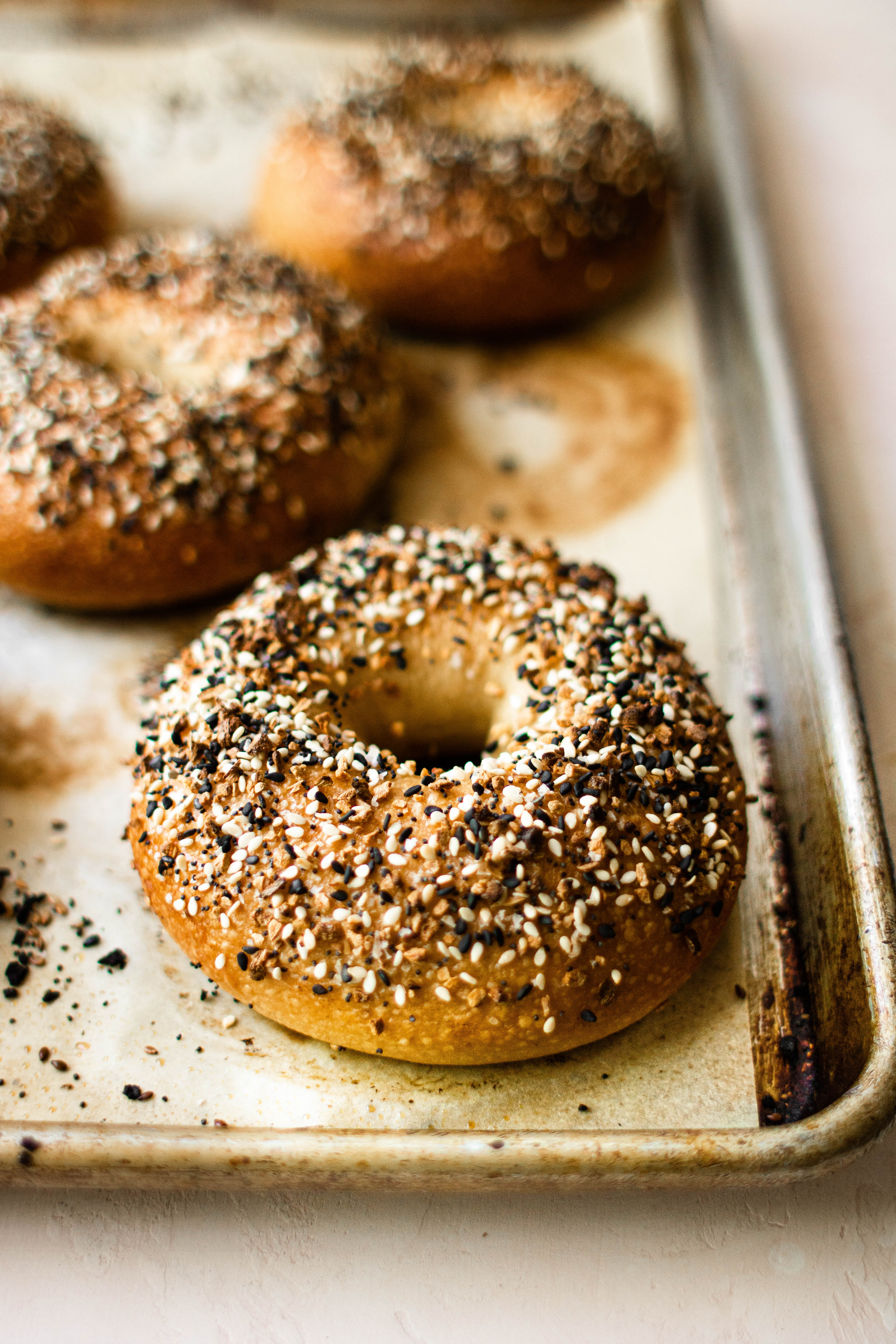
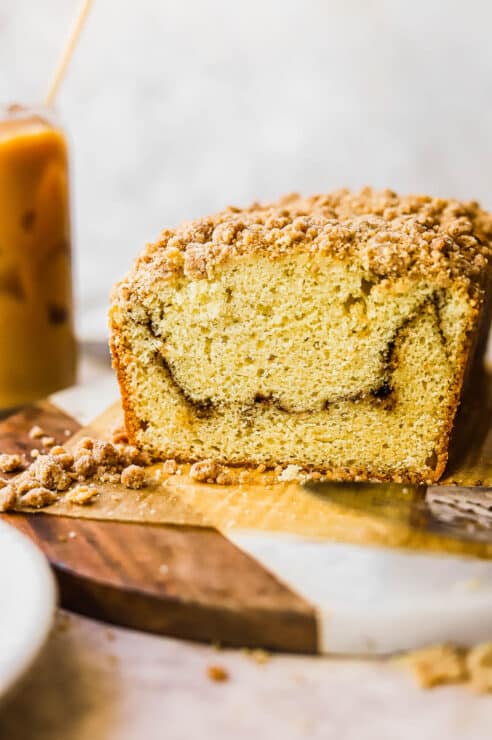
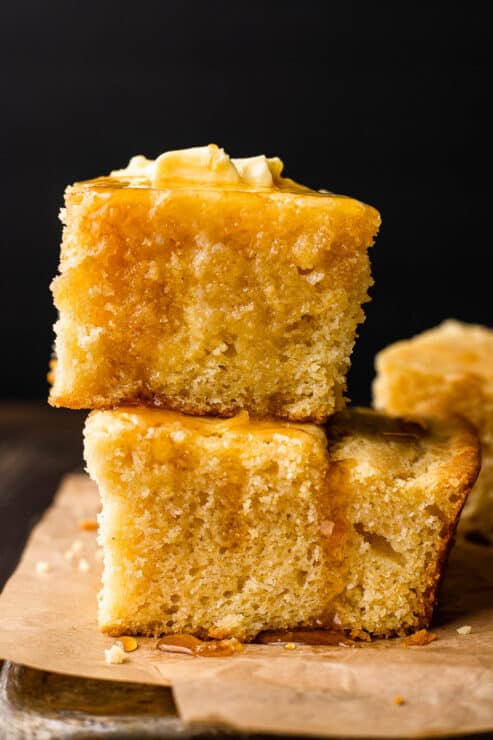
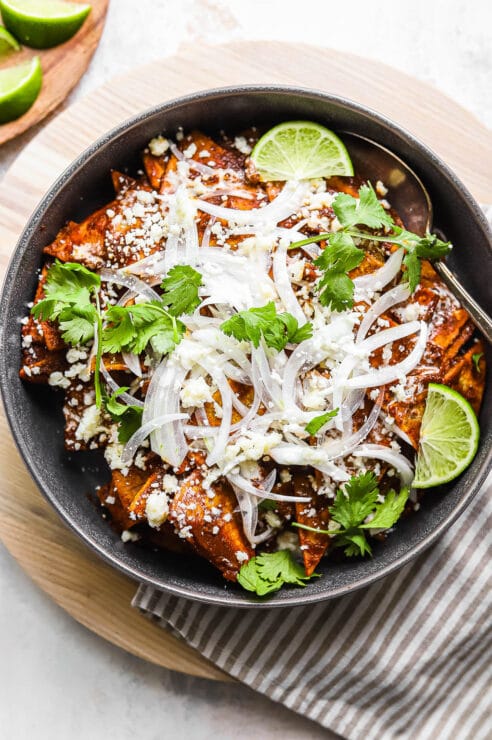
Rate & Review This Recipe
The dough was silky and just wonderful. No extra flour needed. Crisp outside and inside exactly like the bagels I grew up with in New Jersey. Great recipe and results.
So happy to hear it!
Being a bit pretentious and a little snobby, I was prepared to point out what you…a Texan!, had wrong. So I read on planning to give you grief about your ignorant bagel recipe. Boy was I wrong. You’ve got this down to a science. Congratulations. Good attention to detail. I will make a few suggestions. First, try adding a quarter cup of vital wheat gluten to your recipe. Seriously. I add it to my PowerFlour which is over 14% protein. Next, try baking by setting the oven at 550 degrees to preheat and then dropping it to 475 after you place your bagels…preferably on a pizza steel, but a flat half sheet pan will do. I’m with you on the baking soda in the poaching fluid. I also add a small amount of diamond crystal salt. ONe last suggestion, if you plan to make these often..and you should…buy your malt from a beer and wine making shop, or Amazon in…say…36 oz containers. Make sure there are no hops added. You can get 7-9 pound containers of brewer’s malt if you’re a true fanatic. They use this stuff to make malted milk shakes too.
Sad that you get your kicks coming to peoples’ websites to shit on their hard work. For the record, living in Texas does not make me a Texan. But what I am is a former chef and I take my recipe development very seriously. Yikes Peter.
Thank you so much for this recipe! They came out amazing and I can’t get them locally so this was extra special. Do you go straight from fridge to boiling water? I left them out 1.5hrs before boiling.
I made them by the recipe, and an alternative way by skipping the sponge and mixing everything in a stand mixer, let it rise, then form bagels and refrigerate. Both methods came out awesome, the no-sponge bagels were dull with tiny blisters(still delicious) and the sponge bagels were smooth and shiny.
I like to make pizza dough with an overnight sponge so I do love this method. I may have messed up this sponge though, I put it in the oven at 90f to rise and it had a very strong yeast smell when it finished. The finished bagel had a slight yeast smell. Maybe I rose the sponge too quickly?
Also I used Bouncer brand high gluten flour from Gordon food service. I would recommend high gluten flour if available as it has even higher gluten than most bread flour.
Thanks again!
Good morning,
I am happy to let you know that I attempted to make cinnamon raisin bagels again and they were a success!
I soaked a 1/4 cup of raisins in hot water for about 10 minutes, drained them and patted them dry with a paper towel. I then added the raisins, 3 Tablespoons of sugar and 1 teaspoon of cinnamon after the salt was incorporated. The dough was beautiful but sticky so it was trial and error trying to form them. I thought they were not going to turn out the next morning when it came to boil them because they sank again, but I used my spider and they eventually rose to the top. They do not puff up too much when boiled but the bake up beautifully.
I am eating one as I write this and they are SO DELICIOUS. Thank you for sharing your amazing bagel recipe.
P.S. I am going to attempt blueberries next!
Yay! SO happy that they worked out for you! Sounds absolutely delicious.
I absolutely love this bagel recipe. I did have an issue though, I tried to make cinnamon raisin bagels and they sank like a rock when I put them in the boiling water.
I added raisins and cinnamon during the 20 minute mixing and obviously they did not turn out. Can you tell me what I did wrong? Thank you
Hi April! Happy to hear you enjoyed the recipe. I have not personally made these with cinnamon raisin but my guess would be too many raisins inhibited the rising process somehow. I would do a little less and instead of boiling them from cold, let them rise a bit at room temperature (maybe an hour?) before boiling. Would love to hear if that makes a difference next time!
Hi there… I was wondering if there’s any shortcuts for the refrigerating bagels overnight? I don’t mind doing it but sometimes I like baking the bagels, the same day that I mixed them up. Any thoughts?
Hi! You can shape them and let them proof at room temperature for an hour before boiling and baking.
Hi! I followed your recipe this weekend and when I took the bagels out of the fridge in the morning after a good 12 hours they hadn’t risen at all. Then when I boiled them they just sank to the bottom. The final product was ok because we prefer dense chewy bagels but previously I followed the recipe but used more yeast and used the guidance you had given someone to be able to put the dough in a bowl overnight to conserve on space and those bagels did rise and floated almost immediately in the water. Any ideas what I did wrong when I followed the original recipe?
Hi! I’ve actually not ever heard of this happening. I’ve made the recipe both ways many times, but I’ve never had bagels that didn’t rise. My only thought could be that your yeast was old or that the water when mixing it early on was hot enough to kill the yeast. I personally never use yeast packets and instead always use a jar of yeast that I keep in the fridge to keep it fresh. Hope that helps!
Jenny! These are the best bagels! So easy to make, too. I’m from NJ and have really hoped for a good bagel recipe since moving to NC. These are the ones. I followed the recipe exactly.
Here is one thing I want to improve from my results – it may be that I just didn’t bake them long enough and baked too many at once (all eight at once). But the outside could have been more solid. Only the parts verging on overcooked were. I wonder if my malt to water ratio was off. What do you think? Regardless they were delicious and next time I’m going to bake only four at once. They were nicely puffy, too!
Hi Barbara–
Thank you so much for your feedback! I’ve not had anyone mention the outside of the bagel not being solid before but I highly recommend using a scale to weigh the ingredients (if you didn’t already). Even a slight change in the amount of flour changes the hydration of the dough. Otherwise, I think I’m going to adjust the method to only bake 4 at a time as I think it yields much better results. Thanks again!
This is the 3rd bagel recipe I’ve tried and this one has been the best so far for taste and texture. I adjusted the recipe just a bit:
Sponge: 400g water (left covered with plastic wrap in the fridge overnight)
Dough: 9.5g vital wheat gluten (mixed for 20 minutes in a kitchen aid with a dough hook and then refrigerated in a lightly oiled ball covered with plastic wrap overnight again)
Size: ~119g balls when first tightly rolled, before shaping (formed while dough is still cold and left to rise while water comes to a full boil and oven preheats)
Boil: ~30 seconds per side, adding 1/8 tsp of the divided baking soda before every batch of 2-3 bagels – ensuring the syrupy water comes to an aggressive and full rolling boil across the entire surface before each batch
Cook: 425 degrees for 8 minutes, turn pan 180 degrees in the oven so the other half of the bagels face outward, then cook ~7-8 more minutes until desired shade of golden brown
Thank you!
Love all these thoughtful changes, thank you for sharing!
The flavor is so totally there and I am trying to perfect this recipe, however they keep turning out rather flat. I feel like maybe my dough isn’t kneaded enough. Once they poof up and I transfer them to boil it all goes down hill
Hi Ally!
I’ve had that happen to me as well. The trick is to knead really well in the mixer until the dough is elastic and then to shape the bagels tightly. They should be really tight dough balls before making the center hole–that helps hold all the bubbles in. I also tend to boil 3-4 at a time then bake those off immediately and then do a second boil and bake with the remaining. I find that the longer the bagels sit after being boiled, the flatter they can get. I hope that helps you perfect them!
Thanks for answering so fast! That could make sense here because some baked up nice and fat and others not (I’m in the midst of baking right now). I’m also gonna try doing the overnight rise before shaping and then trying a shorter proof time after shaping like you said…maybe my new fridge isn’t cold enough and some are overproofing in there
Depending on where you are, it’s extremely warm out so it could be a contribution. A shorter proofing time should help! Let me know how it goes!
Hi me again lol so the last two times I’ve made these they’ve gone a little flat after boiling. They’ll look really nice and puffy as soon as I take them out of the water but then they deflate. Do you know what could be causing this? Thanks!
Hi! This has happened to me in the past and it’s always been when I didn’t shape the bagels tight enough. They really need to be in a tight ball and when you poke the hole through make sure that they stay tight and smooth. Also, I often boil 3-4, bake those right away, and then bake a second tray so that they don’t sit too long after boiling. Hope that helps!
I’ve tried so many bagel recipes and none ever taste like a bagel. These are PERFECT. Best bagels I’ve ever had. Question: can I make the sponge and let it rise in the fridge overnight? Thanks!
Katrina,
So happy you liked the recipe! Yes, you can definitely do the sponge overnight, but you can also make the dough and chill it overnight before shaping. Just bring it to room temp before shaping and let the shaped bagels do one final rise at room temp. Hope that helps!
Hello there. Just a quick question before I try this recipe. Everything I read says you should only use1/2-1tsp of diastatic malt powder per 3 cups of flour. Your recipe calls for 3 TBSP. Would the dough not rise way too much with that much malt powder? Thank you! 🙂
Karen,
Diastatic malt powder doesn’t cause the dough to rise. The enzymes help give the dough a better rise, texture, and better browning on the exterior. I’ve made this recipe countless times and I’ve never had issues with the dough rising too much. Hope that helps!
These were outstanding and just like the NY bagels I remember! Could I use this recipe to make cinnamon raisin bagels, rolling the dough in cinnamon and sugar, or would that make it too wet?
Martha, I think that would work just fine! Mix the raisins in towards the end of the final mixing and after the boil, sprinkle with cinnamon sugar so as not to deflate. If you try it, I’d love to hear how it turns out!
Hi Jenny,
I finally had a chance to make bagels again and am letting you know how it worked out making them smaller. The full recipe made 10 bagels, each weighing a little over 100g. I boiled them for 1 min on each side (forgot to reduce the boiling time as you suggested!), then baked them at 425 degrees for 20 min. I like the smaller size because then I don’t have to feel so guilty if I eat two! Maybe they would have benefited from being baked a minute or two less but then I wouldn’t have gotten the right amount of browning. Either way, they are perfect. This really is a perfect recipe. Is there a Nobel Prize out there for the best bagel recipe? If so, I nominate you!
Michele,
You are too kind!! So glad those worked out in the smaller side. I’m actually making some this week so I may try a smaller size too!
Hi and thank you for this awesome recipe!
I have a question… it’s a bit of a struggle for me to find space for two sheet pans of shaped bagels in my full family fridge for the overnight aging. I know some bakers will rest the whole ball of dough overnight in a bowl and shape the next day. If I modify your recipe in this way, what do you recommend for the process? Would I put it straight into the fridge after mixing/kneading in the kitchen aid? And next day, should I allow the dough to come to room temperature in the bowl or shape while cold? Any other modifications?
Thank you!
Totally hear you! My recommendation would be to lightly grease a bowl and place the dough in that bowl after mixing, cover with plastic wrap and refrigerate overnight. Shape while still cold, then let the bagels proof lightly covered at room temperature for about an hour before boiling and baking. Hope that helps!
WOW! This is an amazing bagel recipe. I used to make really good bagels and then after a break that lasted several years, I lost my mojo. But you rescued me. Thank you so much for sharing this recipe.
I had non-diastatic malt powder in my pantry so that’s what I used and it seemed to work out fine. I’m thinking I’d like to make the bagels a little smaller next time, maybe around 115g or so. When I do that, do you think I should boil them for a shorter period and/or bake them for less time? For 130g bagels at 425 degrees, they were done in 18 min.
Again, THANK YOU! And I look forward to trying out some of your other recipes.
Michele,
So happy to hear that! I’m glad the other malt powder worked out as well. I would reduce the boil time on smaller bagels to maybe 45 seconds per side, and start checking after 15 minutes of bake time. Hope that helps! Let me know if you do end up trying smaller bagels, would love to add a note to the recipe.
I have been making bagels for a while now. Every time I make them, I make a new recipe…. I have so many recipes for bagels I get totally confused. But confused I am…no more! I have found the PERFECT bagel recipe. Coming from NY myself..and living in the south now…I longed for the delicious bagel I remember. In my search I found Jenny’s bagels. They are the most delicious bagels and so easy to make. I love that it has diastatic barley malt powder in the bagel as well as in the boiling water. It makes quite the difference.. I have stopped searching for the perfect bagel…I’ve finally found it. Thank you Jenny!
Thank you so much Barbara! So happy you love the recipe.
Simply the best home bagel recipe I’ve ever tried. Flawless. I used to use Peter Reinhart’s recipe from “Artisan Breads Every Day”, but was always disappointed with how thin and dense the final product was.
This recipe blows it out of the water. Definitely use the malt syrup and diastatic powder – made all the difference in the taste (and you can reuse both to make awesome homemade pretzels or pretzel bread too). Thanks for posting – this one is going into my Hall of Fame.
Gerald,
So happy you loved the recipe! Thank you so, so much for your kind words!
Jenny
Hands down, the best bagel recipe! I’ve been making bagels for a year now, your recipe is easy to follow, and your sponge method makes all the difference (I’ve tried at least 5 recipes). The dough came out perfect. I recommend folks follow your recipe exactly, they won’t be disappointed. This recipe has been saved as keeper!
Pamela, so happy you loved the recipe! Bagels are one of my favorite things to bake ever!
A true New York bagel recipe. Excellent!
Thanks Patricia! Happy you loved the recipe.
These look fantastic. I have a very small fridge and simply cannot shape the bagels out onto trays before refrigeration. Can I keep the dough and one bowl and shape the next day without too much detriment to the bagels?
Hi Kimberley!
You can definitely proof the dough in a bowl overnight and then shape the next day. After shaping, you’ll want to give the bagels about an hour covered with plastic wrap so they can proof a little longer before boiling. Let me know how they turn out!
Fantastic recipe! Easy to follow and the best flavor/texture I’ve had. I had barley malt syrup on hand and it worked well (adjusted to 1Tbsp in the dough). Looking forward to making them again soon.
Christi,
So happy that you loved it! This is definitely one of my favorite recipes ever!
Made these today and came out so wonderful! I’ve never made bagels before, so it was a bit daunting, but I had a blast. Thank you for the recipe!
That makes me so happy to hear! So glad you liked the recipe, thank you for making it!
Are these crispy on the outside and chewy inside?
Yes, they absolutely are!
Thanks for the recipe. I never tried making bagels with a preferment before. Seeing the kneading time of 20-25 minutes, I thought it was a mistake and could lead to overworked dough, so I kneaded only about 12-13 minutes. Also I used oat flour for part of my ingredients. It turned out tasty. Thanks!
Yay! I’m so glad you liked the recipe, thank you for making it! For reference, I like a really tight crumb in my bagels, hence the mixing time. Because the bagels have a long rest in the fridge, the gluten has a chance to relax and thus there isn’t a risk of over-mixing. Great tip about the oat flour!
Most other recipes call for non-diastatic malt powder. What is your reasoning?
Diastatic malt is dried at a lower temperature to preserve enzyme activity, meaning that the malt is actually working hand in hand with the yeast on this one. Non-diastatic malt has been kiln dried at a much higher temperature and is only added for color and sweetening effects. I would always elect to go with diastatic.
Great Recipe! Easy to follow and the videos for shaping helped a ton! Love the website, love the recipes, keep putting out amazing content!